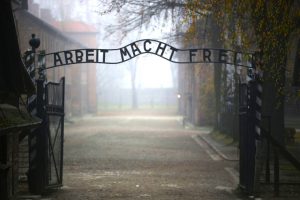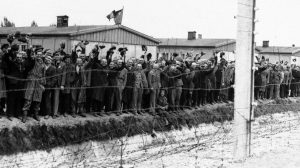It’s been a long time since history delivered WWII. A long time to learn what happened, too.
But not all are interested in the lessons of WWII, particularly the death camps where those deemed undesirable by the German authorities were warehoused until further notice.
Further notice was death for six million people. Six. Million.
For perspective, that’s New York with 2.5 million left after six million leave. That’s Chicago and Houston added together and both depopulated. Six. Million.
My interest in WWII started around fifth grade when I found the P38 Lightning in a library book. A catamaran airplane? How did that fly?
One pilot, Ace of Aces Dick Bong, stirred my imagination when I read about him flying under the Golden Gate Bridge and buzzing San Francisco neighborhoods in a Lightning.
Turn a few pages in a world history book and you’ll find the German death camps. Today you can book a tour if images and text aren’t convincing enough to prove what happened did happen. I toured the museum in Washington D. C. for good measure. While I’ve never been much of a doubter, I never doubted the numbers from WWII.
Six. Million. People. Rounded up. And killed. It’s hard to get a grip on, I know.
Consider the crowds you’ve seen or been a part of. Take the number and find the percentage of six million. Still with me? Leave the answer in comments.
Now add to the number all of your family, friends, acquaintances, everyone in your town, people you know from school, from the store, from work. Everyone.
Gather the most important people in your life, the most important people in their lives, and everyone within five miles of wherever you are. Now picture them in this crowd.
Except they’re all dead.
The scene is shocking and horrible and everything you’ve never wanted to feel man capable of doing. Inhumanity on an industrial level. What else?
Imagine what six million people must look like. Six. Million. It’s a number impossible to comprehend, which is probably the stumbling block of millennial interest in the Holocaust. Why is it important to at least have a passing acknowledgement of such a dark period in history?
From my perspective as a young soldier in the US Army, a college history major, twenty years in the history profession, husband, father, etc., I’ve come up with one reason millennials should know this stuff:
If you were in Germany at the time you would have been one or the other, in the death camp or not in the death camp. Then you’d have a choice: to help those in the death camp, or not.
See how history snakes around? If you didn’t help death camp prisoners you’d either support the government that installed them, or not.
Portland millennials can learn more at the Oregon Holocaust Memorial in Washington park.
During the Holocaust, many Jewish families were gathered in town squares before being loaded onto trains and taken to concentration camps. The square contains scattered bronzes of shoes, glasses, a suitcase, and other items to represent everyday objects that were left behind. A European-style, cobblestone walkway with inlaid granite bars, simulating railroad tracks, leads to a wall of history panels – giant, stone placards that offer a brief history of the Holocaust and quotes from Holocaust survivors. At the end of the wall is the soil vault panel. Buried below the panel are interred soil and ash from six killing-center camps of the Holocaust – Chelmno, Treblinka, Sobibor, Belzec, Majdanek, and Auschwitz-Birkenau.
The Oregon Jewish Museum and Center For Holocaust Education on 724 NW Davis Street is ready to answer millennial questions.
Daily we are faced with this double-edged sword. In one sense, that is a good thing: our work matters more than ever. Whether we are teaching students why it is important to resist injustice and to support their peers in need, or creating exhibitions about discrimination and the Holocaust, we harness the power of education and the inspiration of creativity. We expose the roots of hate, to be sure, but also reflect on the right responses to hate, as we inculcate values of inclusion and respect. And we do this, as always, by telling stories: Stories help us understand where we have come from, and stories help us wrestle with the major dilemmas of our time so that we all can create a future in which human dignity will play a greater role than ever.
Learn history, then decide which side you belong on. There’s only one choice.




